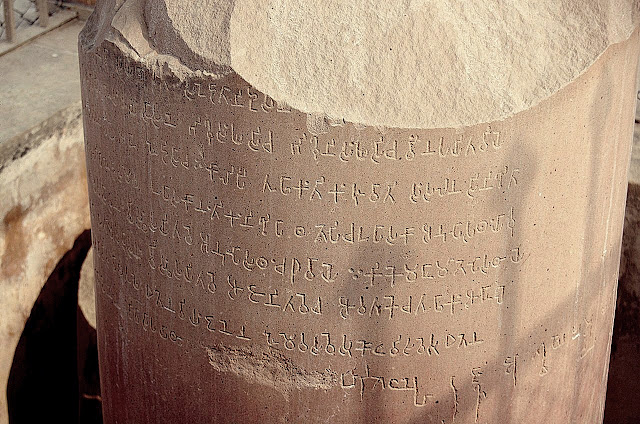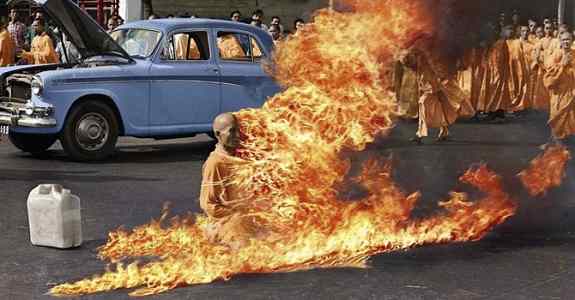Theravada vs. Sarvastivada vs. Archaic Buddhism
Orthodoxy is the diehard of the world of thought. It learns not, neither can it forget. —Aldous Huxley
Orthodoxy is my doxy—heterodoxy is another man’s doxy. —William Warburton
Those of you who are familiar with the history of early Buddhism may know that around the time of the 3rd Great Council, held during the reign of the Indian Emperor Ashoka, a schism occurred between the Theravada and Sarvastivada schools of Buddhism. The orthodox Theravadin version of the event is that certain non-Buddhist heretics had infiltrated the Theravada Buddhist Sangha, and were purged at the 3rd Council, presided over by the Paul the Apostle of Theravada, ven. Moggaliputta Tissa, with the blessings of the Emperor himself. So one of the main purposes of the 3rd Council was to drive the monks favoring Sarvastivadin ideas out of the Sangha of the Theras, and presumably to formalize Theravadin Dhamma with the help of a new Abhidhamma Pitaka.
Historically these “heretics” wallowing in pernicious wrong view then migrated in a northwesterly direction, so that the area now known as the Punjab became a stronghold of Sarvastivada, and the later Kushan Empire, with its capital in what is now Peshawar, Pakistan, converted to that school. The Greeks who ruled that part of the subcontinent before the Kushans may also have favored Sarvastivada.
Of course the orthodox view of Theravada is biased and uncharitable towards the banished side of the schism, not even considering them to be Buddhists in good faith. I seriously suspect that the orthodox Sarvastivadin version of the story would not be extremely charitable towards the Theravadins.
Theravada Buddhists, especially Asian ones, tend to be of the opinion that Theravada is the pure, pristine version of Buddhism, the genuine teaching of Gotama (not Gautama) Buddha before heresies like Sarvastivada and Mahayana corrupted it. I used to believe this sort of thing myself, before I began a serious study of the Pali Tipitaka. But if we consider a comparison between Theravada and Sarvastivada we may see that probably neither side was endorsing the 100% pure genuine article of Buddha-vacana.
The most obvious difference between the two closely related schools is found in the name of the non-Theravadin branch: “Sarvastivada,” or “Sabbatthivada” in Pali, literally means “the Doctrine (that) All Exists.” This means that the Sarvastivadins had a more or less Einsteinian conception of time, so that past, present, and future are all equally real, in a sense. The Theravadins mocked this idea, preferring a more Newtonian idea: only the present moment exists, and the past and future are completely nonexistent.
The only text of the Abhidhamma Pitaka that I have read in its entirety, in the PTS English translation, is the Kathavatthu, or Points of Controversy. This strange book is a guidebook for Theravada Buddhist polemicists, telling them how to refute various heretical doctrines championed by other schools of (early, pre-Mahayana) Buddhism existing at around the time of the 3rd Council, say mid-3rd century BCE. This in and of itself is very strong evidence that the historical Buddha never taught the Kathavatthu, but devout Burmese Buddhists will say that the Buddha had prophetic powers and could foresee these wrong views and provide solid arguments against them…despite the fact that not engaging in such debates was a fundamental tenet of the earliest Buddhism. Anyway, the way to refute the Sarvastivadin doctrine that past, present, and future all exist is by pointing out that they are insisting that what doesn’t exist (i.e. past and future), exists, which is self-contradictory, nonsensical, and invalid. It is unfortunate that rules of formal logic were unknown to pre-Mahayana Buddhists. The whole Kathavatthu consists of specious reasoning like this.
Another fundamental teaching of Sarvastivada appears to stem from the former one, namely that all formations are impermanent, but the elemental dharmas of which they are made, are permanent. So unlike the Theravada notion of all things, even elemental ones, physical and mental, blinking in and out of existence trillions of times per second, the Sarvastivadins declared the permanence of elemental matter and mind.
There are other differences between these two schools; for example the Sarvastivadins were allegedly obligate vegetarians, whereas the Theravadins were and are not. Also the Sarvastivadins had an almost materialistic conception of karma, and every single book in their version of Abhidharma differs radically from the books of the Theravadin Abhidhamma—this point in itself being good evidence that the Abhidhamma Pitaka simply did not exist prior to the 3rd Council—but the differences already mentioned are enough to demonstrate a point I intend to make.
The point is this: that most differing points of view belonging to the various schools were differing interpretations of already existing texts (though at the time the “texts” were probably memorized and not written down), not the radical changing of central doctrines. THAT was mainly what the Mahayanists succeeded in doing, which separates them from the earlier Shravakayana or “Hinayana” schools.
I’m pretty sure that the Buddha did not categorically declare that past and future do or do not have some metaphysical reality. He did have some prophetic power, accepted even by the Theravada Buddhists, so he could see the future, which to a Theravadin absolutely does not exist; but the Theravadins claim that in his omniscience he could extrapolate a current situation into its extremely probable if not inevitable future state. The Sarvastivadins might have the advantage of interpretation on that one.
But since there is no formal declaration one way or the other in the early, core texts, different monastic scholars could come up with different grand unified theories to tie everything together and explain the entire cosmos to the satisfaction of an ancient Indian intellectual. The same goes for the interpretation of the impermanence or inconstancy of sankharas or conditioned things; though in THAT case the blinking on and off theory of the Theravadins might come closer to the original spirit than the idea that only combinations of elemental dharmas are inconstant—sort of like a 19th-century physicist insisting that molecules are not eternal but that atoms are. Radical divergences between rival schools as found in their scriptures tended to rely on apocryphal texts, if not on varying interpretations of an ambiguous statement.
Situations like these weakened my faith in orthodox Theravada almost from the time that I began seriously studying Theravada. It seems very likely that Theravada is not necessarily the closest school to the authentic teachings of the Buddha (though Buddhistic scholars like A. K. Warder are of the opinion that Theravada was one of the most conservative schools of ancient India), but rather that it survived, and the other early schools did not. I doubt that the Buddha really taught the blinking on and off trillions of times per second theory, for example—a theory with some serious logical defects, not the least of which is the following: if everything blinks out of existence every moment, then what is the cause of them blinking back into existence again? Theravada categorically denies the reality of the past, so even the past moment cannot cause anything in the present because it would be a nonexistent cause and thus no cause at all. Also, how could anyone observe this blinking on and off when the process of observation itself would be nonexistent during the “off” times?
Choosing a school of Buddhism during its first few centuries of existence would probably have been more a matter of geography than of discriminating among the philosophies. Probably the gradual separation of Buddhism into various schools was caused by isolation and a kind of genetic drift: monks could not travel any faster than a monk could walk, so there was not much exposure to alternative points of view in early monasteries, except in the larger cities, the universities, and the main pilgrimage sites like Bodh Gaya and Savatthi. Local teachers would naturally have some authority at their own monasteries, which would tend to vary from what some other teacher was teaching many miles away. So whatever school of Buddhism was prevalent in a person’s native area of India was likely the school of Buddhism that he would follow. Religion is still this way today, and a person’s religion tends to be more a matter of geography than theology.
So Theravada adhered pretty closely to the core texts of Buddhism, that is the state of Buddhist texts before the first schism about a hundred years after the Buddha’s parinirvana, and eventually cooked up a grand unifying theory to bring the texts into some semblance of harmony. Or rather, Theravada cooked up more than one such theory and purged the ones that did not command the majority of monks, or that did not persuade the elders calling the shots, like old Moggaliputta Tissa.
I think the world had some pretty good karma in that of all the early schools Theravada is the one to survive. (I have read that Sarvastivada technically still survives in a few monasteries in Japan, there called the Ritsu or Rissu school, but it has been overwhelmed by Mahayanist culture and hardly represents a pale shadow of the Indian heretics purged at the 3rd Great Council.) Buddhism, as it has spread into different cultures, has mutated into some forms barely recognizable as Buddhist, but the core texts are still there, even if surrounded by non-core interpretations and some apocryphal suttas.







Can you please ivite me to your discord server? @matgioi
ReplyDeleteHey man, you haven’t posted in a few months, is everything alright?
ReplyDeleteWell, here's the thing: I work full time as a layman now, and instead of working on blog posts pretty much any time I wanted it became necessary to write a post each weekend. But now I'm doing Q&A videos almost every Sunday, which has pretty much taken up the time for writing on this blog, and has pretty much replaced it, at least for now. (But this weekend I am slightly ill and am spending my weekend in bed and on the couch, doing as little as possible.) Anyway, the YouTube channel is:
Deletehttps://www.youtube.com/channel/UChQJMvdH3Is-fw7rVhYd4uA/videos
Cheers for the reply. Glad to hear your doing relatively well and I wish you a speedy recuperation.
DeleteHi Pannobhasa, I’m sure you posted this elsewhere, but what is the online link to your translation of the atthakavagga? Thank you
ReplyDelete